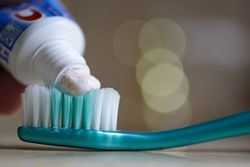Toothpaste
Toothpaste is gel or paste that is used to brush teeth and promote oral hygiene. There are many different interesting ingredients that are inside toothpaste. Behind each ingredient is a purpose, whether it is to provide abrasiveness or to give a better taste. Toothpaste can also be used in many different ways. Some uses are very surprising and can fix many problems people have today.
Ingredients
Toothpaste originated thousands of years ago in ancient Egypt. Egyptians used creative materials in their toothpaste such as ox hooves, burnt egg shells, and pumice. The ancient Greeks and Romans focused on adding abrasives to toothpaste such as crushed bones and oyster shells. The Romans, then, used charcoal in their toothpaste which is a method still used. [1] The Chinese put ginseng roots, mints, and salt in their toothpaste, which had a more appealing taste. In the mid 1800s, toothpaste began to develop more, especially in England. The people there put soap in the toothpastes, but later on, different ingredients were added to give the toothpaste a creamier texture, like it is today. In the 1900s, toothpaste was made to prevent damaging teeth by using weaker abrasives. [2]
Fluoride was also added to toothpaste when there was a discovery that it prevented decay and cavities. [3] Today, there are many different kinds of toothpaste, which means that the source of a certain toothpaste varies. [4] The most common ingredient for toothpaste is water. The water gives the toothpaste the moist, sticky texture it has. Another common ingredient used in toothpaste is fluoride. There are a few different types of fluoride used in toothpaste, however, there is controversy lurking around fluoride with many people saying that it has more negative effects than it does positive. [5]
Ingredient Purposes
Back in the day, people preferred abrasive toothpastes. Ox hooves and burnt, crushed egg shells were just perfect for abrasiveness. Pumice is a volcanic rock that, today, is most commonly known for being an ingredient for concrete. [6] The ancient Egyptians crushed pumice until it formed a powder. This was also used as an abrasive, however, they were better known to be used as soaps rather than toothpastes. [7] The Romans used charcoal in their toothpastes which is very popular today. You can usually get charcoal by heating up wood or bone without exposure to oxygen until it turns black.
Many people say that charcoal toothpastes aren't healthy for your mouth because they are too abrasive. Too much abrasiveness can lead to the damaging of the enamel. It is also said that charcoal actually whitens teeth compared to other toothpastes, but it is not recommended to use it. [8] When ancient Chinese first made toothpaste, they added ginseng roots to give a better taste. Ginseng roots are thought to have may benefits such as a boost in energy, stress relief, and relaxation boost. [9] Fluorides are compounds that form in rocks and soil, but water flows into big bodies of water. In toothpaste, fluoride is used to prevent tooth decay. Some professionsals, however, say that cental fluoride is simply the destruction of enamel. [10]
Uses
Toothpaste can be used in many different ways. The main use, and the reason why toothpaste is invented is for brushing teeth. A different way toothpaste can be used is to remove scratches or damage on random objects. If your dress shoes are ever scratched, just rub a little toothpaste on it and the scratch will disappear. When silver jewelry gets old, it looks rusty and it wont have the same shiny look it did have when it was first purchased. Toothpaste can be rubbed and it will look brand new. [11] Toothpaste is the solution to one of the most annoying surprises that you discover in the morning; pimples. When toothpaste in dabbed onto a pimple, there will be a burning feeling. This is the feeling of the pimple drying out from the ingredients inside of the pimple. However, toothpaste can also over-dry skin and cause redness and peeling. [12] Toothpaste is also great at defogging. When your bathroom mirror, car headlights, and goggles get foggy and oxidized, toothpaste is a great solution. Just rub some toothpaste onto anything foggy, rinse it off, and you are good to go. [13] Another great use for toothpaste is to get rid of the cracks on a phone screen. In an era where so many people own phones, this is a useful tip. [14] Watch the video down below for some more ways toothpaste can be used!
Video
This is a visual of different ways toothpaste can be used.
References
- ↑ Where Did Toothpaste Originate From? Fairway Dental. Accessed November 16th, 2017. Author Unknown.
- ↑ History of Toothbrushes and Toothpastes Colgate. Published June 12th, 2006. Author Unknown.
- ↑ Prichard, Denise A Brief History of Toothpaste Spear. Published November 20th, 2012.
- ↑ Oral Care Guide for Teens Tooth Club. Accessed November 16th, 2017. Author Unknown.
- ↑ Toothpaste Ingredients Total Health Magazine. Accessed November 16th, 2017. Author Unknown.
- ↑ Hunt, Walter Ingredients for Toothpaste Personal Care Dentistry. Accessed December 5th, 2017.
- ↑ Jeppsen, Brian Pumice for Exfoliants and Scrubs Hess Pumice. Accessed December 6th, 2017.
- ↑ Hubbard, Lauren Charcoal Toothpaste Pros and Cons Harpers Bazaar. Published August 9th, 2017.
- ↑ Nordqvst, Jordan What is Ginseng?Medical News Today. Last Updated September 20th, 2017
- ↑ What is Fluoride? Colgate Enamel Health. Accessed December 6th, 2017. Author Unknown.
- ↑ 9 Ways You Never Thought to Use Toothpaste Tip Hero. Accessed December 7th, 2017. Author Unknown.
- ↑ Kitchens, Simone Toothpaste To Dry Out Pimples? The Huffington Post. Published October 23rd, 2017.
- ↑ McAfee, Elan How to Clean Oxidized Headlights Your Mechanic. Published December 30th, 2015.
- ↑ Godfrey, Alice How to Fill a Cracked Screen With Toothpaste Techwalla. Accessed December 7th, 2017.
| ||||||||||||||



